
This 17-minute vidoe lesson shows proof of the Cauchy-Schwarz Inequality.
- Subject:
- Algebra
- Mathematics
- Material Type:
- Lecture
- Provider:
- Khan Academy
- Provider Set:
- Khan Academy
- Author:
- Salman Khan
- Date Added:
- 02/20/2011


This 17-minute vidoe lesson shows proof of the Cauchy-Schwarz Inequality.

This 11-minute video lesson proves the "associative," "distributive," and "commutative" properties for vector dot products.

This 23-minute video lesson looks at Rowspace and Left Nullspace. [Linear Algebra playlist: Lesson 97 of 143]

This 9-minute video lesson provides definitions of the vector dot product and vector length.

This 19-minute video lesson proves the triangle inequality for vectors in Rn.

This 20-minute video lesson looks at the relationship between left nullspace, rowspace, column space and nullspace. [Linear Algebra playlist: Lesson 98 of 143]
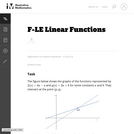
This task requires students to use the fact that on the graph of the linear function h(x)=ax+b, the y-coordinate increases by a when x increases by one. Specific values for a and b were left out intentionally to encourage students to use the above fact as opposed to computing the point of intersection, (p,q), and then computing respective function values to answer the question.

This task gives a variet of real-life contexts which could be modeled by a linear or exponential function. The key distinguishing feature between the two is whether the change by equal factors over equal intervals (exponential functions), or by a constant increase per unit interval (linear functions).
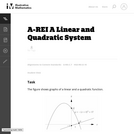
This task asks students to consider the linear and quadratic functions appearing on a coordinate plane.

This 14-minute video lesson provides an Introduction to linear transformations.

This task can be implemented in a variety of ways. For a class with previous exposure to the incenter or angle bisectors, part (a) could be a quick exercise in geometric constructions,. Alternatively, this could be part of a full introduction to angle bisectors, culminating in a full proof that the three angle bisectors are concurrent, an essentially complete proof of which is found in the solution below.
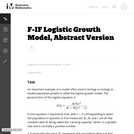
The goal of this task is to have students appreciate how the different constants (P0, K, and r) influence the shape of the graph.
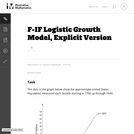
This problem introduces a logistic growth model in the concrete setting of estimating the population of the U.S. The model gives a surprisingly accurate estimate and this should be contrasted with linear and exponential models, studied in ``U.S. Population 1790-1860.'' This task requires students to interpret data presented.

This task builds on studentsŐ prior knowledge and understanding of conditional probability, and introduces the concept of independence of events.
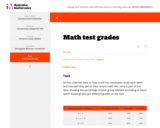
The goal of this task is twofold. For part (a) since we are not given how large each of the groups in the table are, the best we can do is to apply reasoning about ratios (in the form of percents) to give a range of possible answers. For part (b), the goal is to recognize a misuse of statistical reasoning.

Showing that matrix products are associative. Created by Sal Khan.
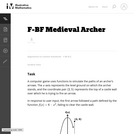
This task addresses the first part of standard F-BF.3: ŇIdentify the effect on the graph of replacing f(x) by f(x)+k, kf(x), f(kx), and f(x+k) for specific values of k (both positive and negative).Ó Here, students are required to understand the effect of replacing x with x+k, but this task can also be modified to test or teach function-building skills involving f(x)+k, kf(x), and f(kx) in a similar manner.

This classroom task gives students the opportunity to prove a surprising fact about quadrilaterals: that if we join the midpoints of an arbitrary quadrilateral to form a new quadrilateral, then the new quadrilateral is a parallelogram, even if the original quadrilateral was not.
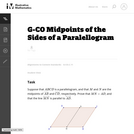
This is a reasonably direct task aimed at having students use previously-derived results to learn new facts about parallelograms, as opposed to deriving them from first principles. The solution provided (among other possibilities) uses the SAS trial congruence theorem, and the fact that opposite sides of parallelograms are congruent.

The purpose of this task is to emphasize the use of the Remainder Theorem (a discussion of which should obviously be considered as a prerequisite for the task) as a method for determining structure in polynomial in equations, and in this particular instance, as a replacement for division of polynomials.